Entering the Schematic using Generic Libraries
Starting the Project
Begin by starting OrCAD Capture, or OrCAD Capture CIS, any licensed version, including the OrCAD Trial, may be used for this example. Then, in the opened Capture application, use File>New Project to start a New Project, name the project Headphone, for example, check the Enable PSpice Simulation, and specify a folder for the project location. Use Workspace is optional but will fix the folder location.
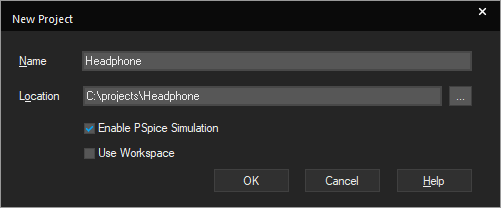
Base the new project on the empty.opj existing project when prompted for a project template.
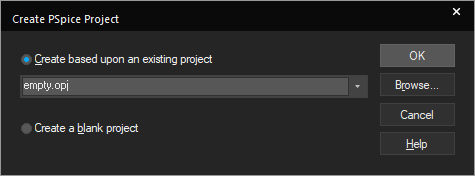
Placing the parts
Use the completed schematic in the Introduction for this example for reference as you enter the schematic. The exact layout of the schematic is not critical to having a working example but correctly connecting the various elements will be required to get the circuit to work as expected.
Left-click on the "+" for ""headphone.dsn" and then the "+"" for SCHEMATIC1", double-click on the Page1 entry to open the Schematic Page. Left-click in the opened Schematic Page to activate it.
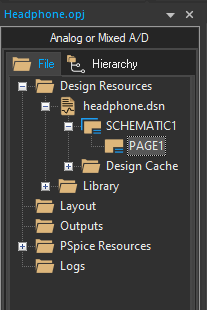
Place the first component which will be the POT. From the menu, Place>Component.
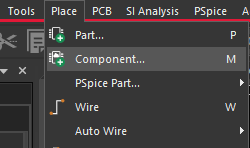
If necessary, left-click>PSpice to activate the PSpice library list. In the Search, at the top of the Component Explorer pane, type POT and press enter to get the POT search results and double-click the POT entry to get the schematic page activated with the graphical part for the POT on the mouse cursor.

Use right-click>>Rotate, or press the R key on the keyboard, to rotate the POT so that the "Resistor section" is vertical with the wiper pin to the right, or left, of that, then left-click the mouse to place the POT part towards the upper left of the page, right-click>End Mode, or use the Esc key, to end placing.
Note that which "end" of the POT that the wiper is connected to will not be critical, PSpice will be used to simulate the circuit bias to evaluate the required set point for the POT.
Double-click on the POT symbol and change the Value property from the default 1k to be 50k and close the property editor tab, accept any changes; or double-click on the 1k text and change the text value to 50k, then left-click>OK to set the value. In both cases note that the value of the POT should now be 50k, rather than the default 1k. If required, left-click on the SET=0.5 text and drag the mouse to move this text away from the POT pin so that any added wires do not obscure the text.
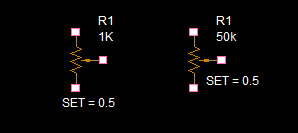
Use File>Save from the menu to save the current schematic.
Place Resistors
Next place the four resistors to complete the input bias chain. Return to the Component Explorer tab and type resistor in the Search. Double-click the entry for Part Name: R, Manufacturer: PSpice and Description: Resistor to get the resistor on the mouse cursor in the Schematic Page. Again, rotate the resistor symbol so that they are vertical, drop the resistor pins together, right-click>End Mode, or use the Esc key, to end the placing command and then left-click and drag the resistors to get the wires added.
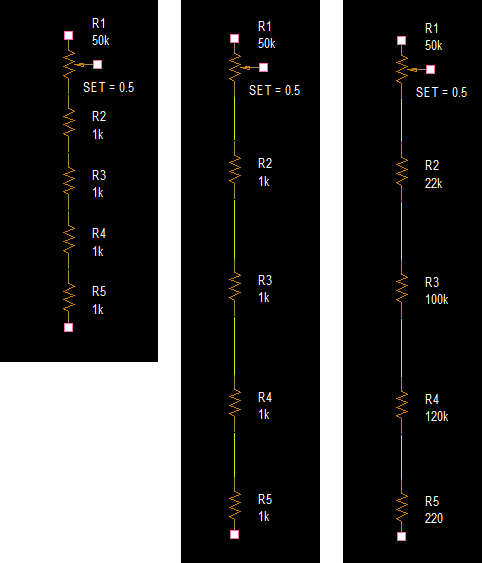
Use File>Save from the menu to save the current schematic.
Once the wires have been added change the value of the resistors to meet the requirements of the circuit, double-click on the default 1k value and change the text to the required values. Don't be too concerned about the exact placement of the components at this stage, their positions can be changed as the circuit is completed.
Next place the three capacitors, C1 to C3. Note that, as far as PSpice is concerned, Capacitors are not polarised, regardless of value, even though actual circuit components probably will be polarised for the larger capacitance values. Return to the Component Explorer and type capacitor in the Search. Double-click the entry for Part Name: C, Manufacturer: PSpice and Description: Capacitor. Change the values from the default 1n values to the values required for the circuit. Then use Place>Wire from the menu, or the W key, to enter wiring mode and make the initial connections, as shown, left-click on a pin to start the wire, move the mouse to draw the wire, left-click to add any corners to the wire and left-click on the destination pin to complete the connection(s), right-click>End Mode, or use the Esc key, to end wiring mode. (Note that the right hand half of the image has the wires attached to the capacitors.)
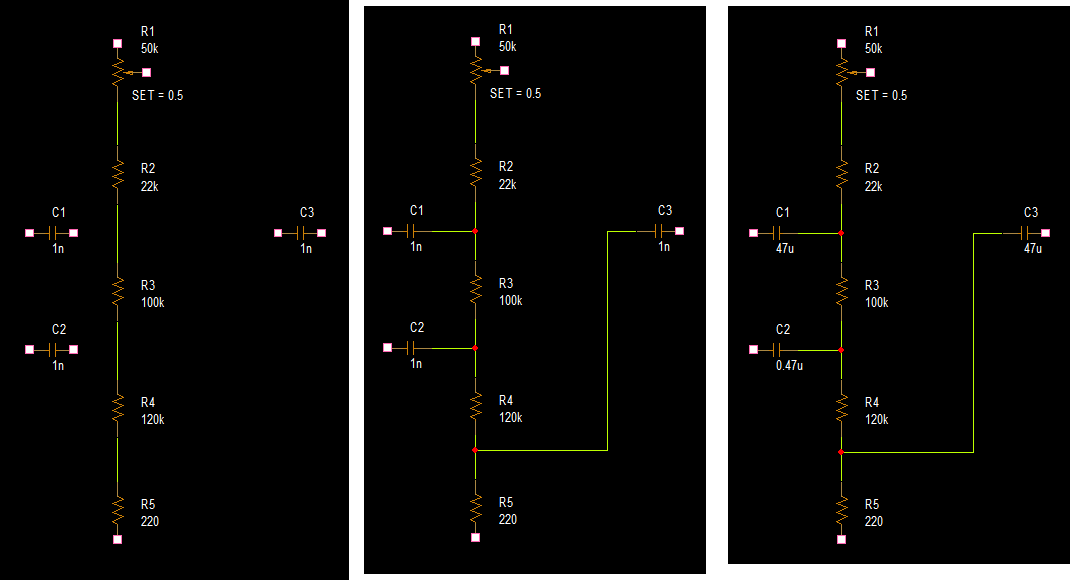
Use File>Save from the menu to save the current schematic.
Now continue to place and wire the next stage of the schematic. When placing the BC857 PNP transistor, use right-click>Mirror Vertically while the part is on the cursor to get the emitter at the top of the part. The BC847 and BC857 parts can be placed from any of the search results.
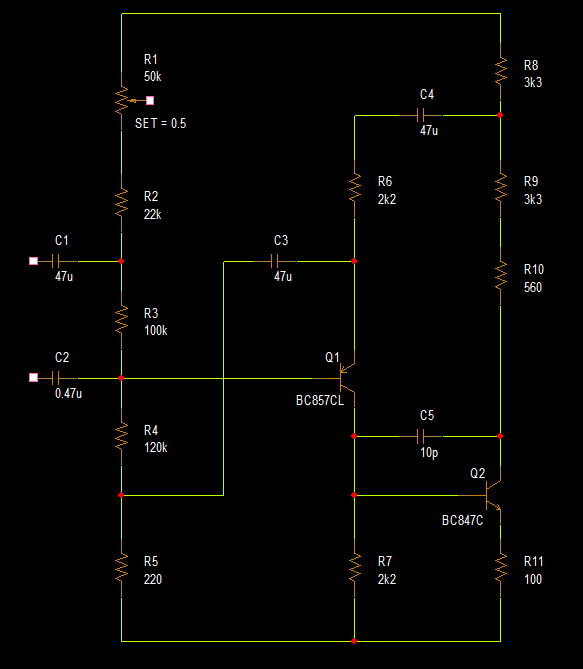
Now continue with the schematic, working towards the right, use the "Mirror Vertically" option when placing the PNP transistors to get the Emitter towards the "top", or "bottom", as required. Also add the connection for the wiper of the POT component and the TIP41 and TIP42 transistors.
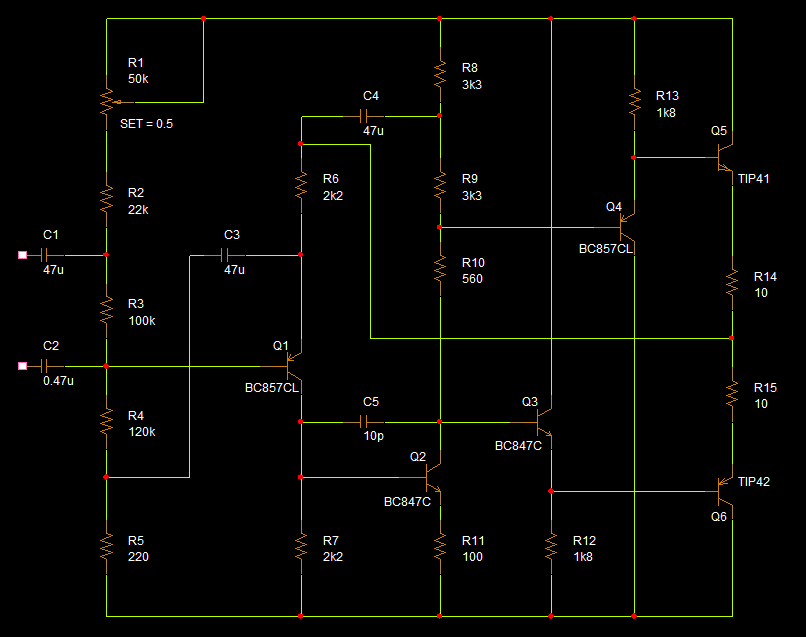
Use File>Save from the menu to save the current schematic.
So far, all the wires have default, system assigned, names, these will be formatted as "N" followed by an identifying number. Whilst these names will work perfectly as far as the design is concerned, it will be much easier to identify key net names if the default net names are overridden with Net Aliases. From the menu, Place>Net Alias (or press the N key), this form will open:
Then type the required Net Alias name to assign in the Alias field, the value needs to be MID in this case and left-click>>OK. The Net Alias value will be attached to the cursor and can be applied to a net by clicking on the net to "stick" the Net Alias to it.
(Some things to note about placing Net Aliases: IF the Net Alias ends in a number, the number will be automatically incremented, so a value of A0 will become A1 and so on, it is not possible to disable this; The Net Alias value will remain on the cursor so that it can be assigned to other wires, note that nets of the same name on the same schematic page will automatically be connected by the netlister so don't "accidentally" apply the same Net Alias to Nets that you do not intend to have connected.)
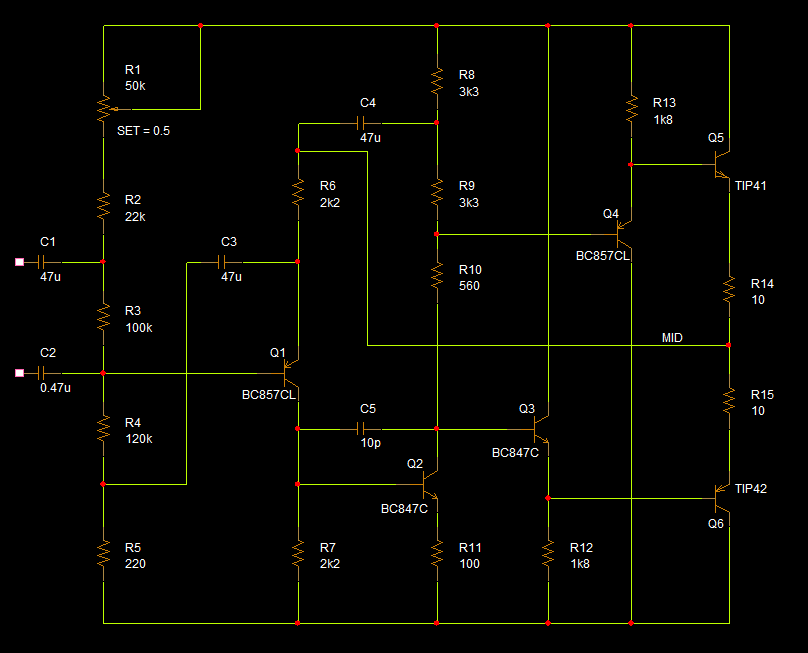
Now complete the schematic, as shown below. Place a VSIN, Part Name: VSIN, Manufacturer: PSpice, Description: Transient sine Voltage Source, referenced V1 in the schematic image, and set the properties: VOFF to 0, VAMPL to 10m, FREQ to 1k and AC to 1; for information: this will provide a 10mV sine source at 1kHz for Transient Simulations and a 1V source for AC Sweep simulations, those are covered later. Place a VDC, Part Name: VDC, Manufacturer: PSpice, Description: Simple DC Voltage Source, referenced V2 in the schematic image, for the power supply, change the 0Vdc value to 20 for this circuit, PSpice will "know" that the value is a DC voltage, so it is not necessary to specify V, or Vdc, with the value. Use Place>Ground from the main menu to place the 0 symbol required for the PSpice reference, this is from the Capsym library. Then use Place>Net Alias and assign the IN, OUT and VPP Nets Aliases to the wires as shown. When placing the Net Aliases, control+E can be used to change the name on the cursor, rather than using Place>Net Alias three times.
Use File>Save from the menu to save the current schematic.
Add the connectors
Left-click in the Schematic Page to activate it and then use Place>Part from the main menu. In the Place Part form at the right, left-click the Add Library icon to open a browser and add the Connector, from the tools\Capture\Library folder of the product installation. Type header 2 in the Part box and Double-click the Header 2 part in the list to get the part on the mouse cursor and use left-clicks to place 3 connectors in the schematic page. Add the connections to match the example schematic.
IF simulating with PSpice, add the library for the simulation models to the configuration. The easiest way to do this is: select one of the connectors, J1 for example, and right-click>Associate PSpice Model. (OK the message that this part already has an Implementation Property if one appears.) Use the Browse button to navigate to the Library\PspiceMiscLib folder in the downloaded data, double-click the Header2.lib file. There will be one matching model, and the Pins will already be mapped to Model Terminals. Left-click>Update All and OK the message that the three connectors have had PSpice models assigned. Also the 300 Ohm load resistor, R17 in the sample schematic, needs to be ignored by the netlist. This part has only been added to aid in the PSpice simulation and is not required for the actual design, the load will be the "headphones". Double-click the R17 part in the schematic page, then left-click on New Property and add a new property Name: PSpiceOnly with a Value: TRUE. Left-click>OK to add the property and accept any other messages. Use File>Save to save the design.
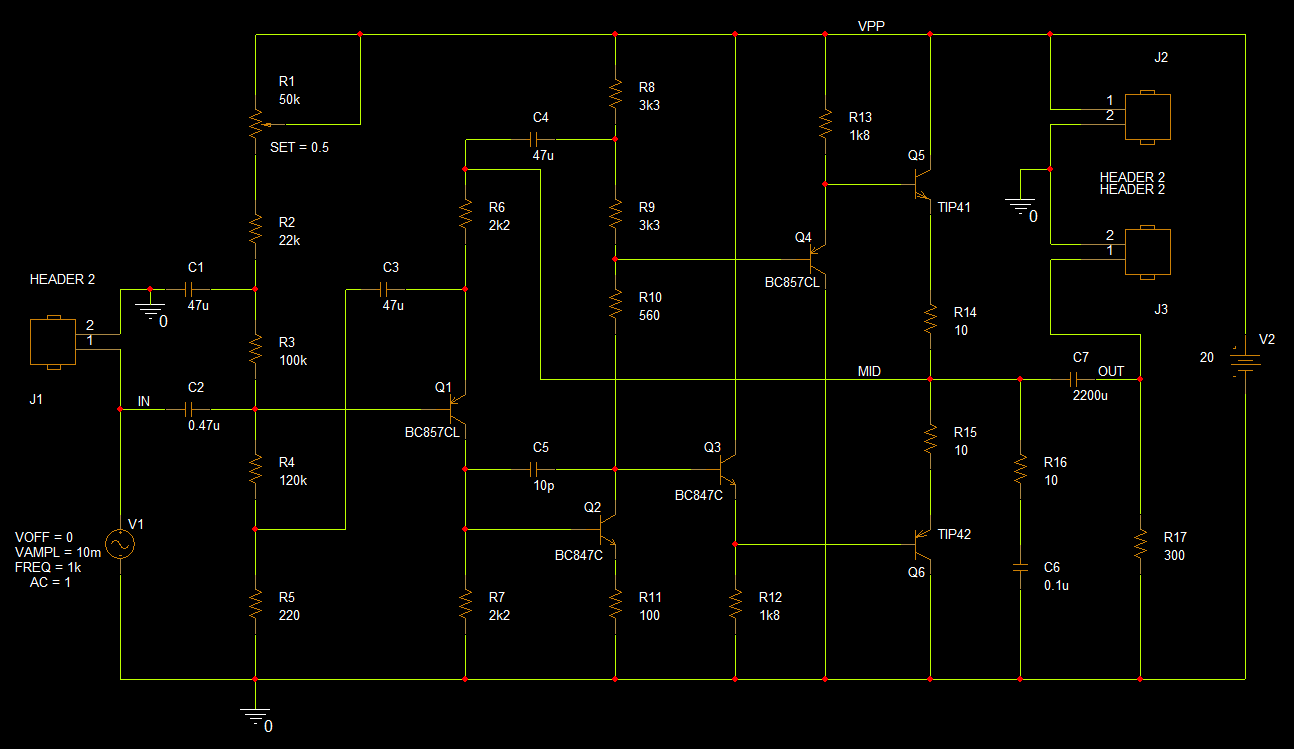
IF laying the board out, add the PCB Footprint Property Values:
Using libraries from the downloaded data:
1. Select the part J1 and right-click>Edit Properties to launch the Property Editor (double-click on the part J1 will also bring up the same Property Editor).
2. Enter a value for the PCB Footprint property for J1 in the appropriate cell. In this example the PCB Footprint is called HDRV2W66P0X254_1X2_508X254X874P, you only need to specify a PCB Footprint name, no extensions are required.
3. Save the changes and close the Property Editor with the “x” in the tab.
You can apply other properties to parts using this method like Manufacturer, Part Number, and Tolerance etc. Properties on parts are used to create PCB Editor Netlist files and manufacturing data like a Bill of Materials. A second method to add many properties in one step is to use the Browse method.
4. Select the headphone.dsn in the project pane then Edit>Browse>Parts
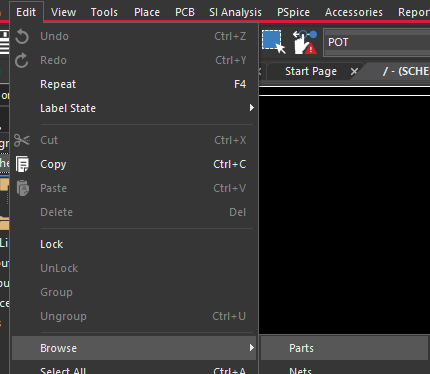
5. Accept the message about the property preferred mode. (For further information on Instances vs Occurrences properties please refer to the OrCAD Capture User Guide).
6. You will now see a list of all the parts in the Capture design. We only need to be concerned with the parts that will be used for the Physical layout. We can ignore the PSpice parts so, left-click C1 followed by a shift+left-click R16, the rows will highlight
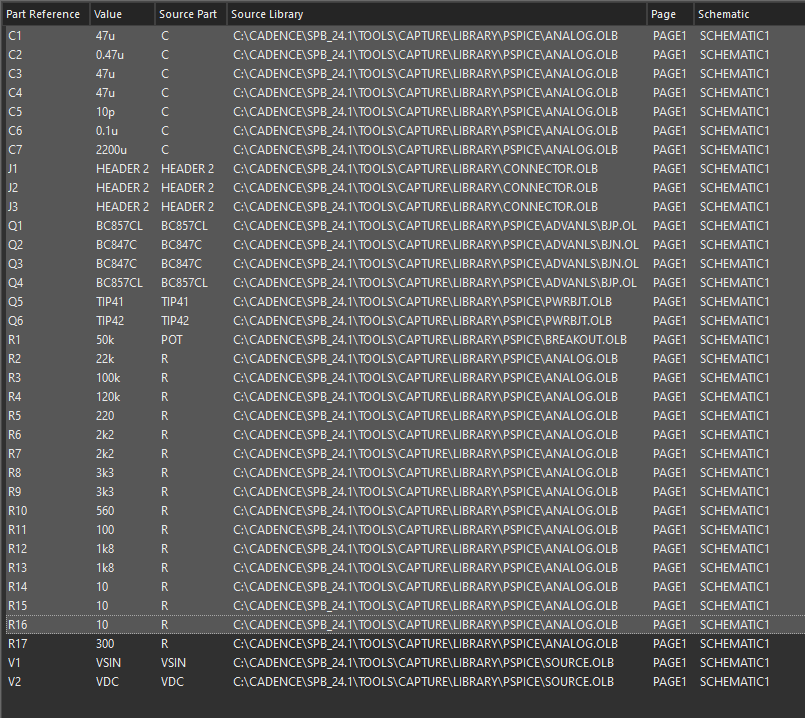
7. Choose Edit>Properties (or CTRL+E) to launch the Browse Spreadsheet window. This is an editable table where you can edit existing property values or add new Property values like Manufacturer, Part Number that will be used for the Bill of Materials.
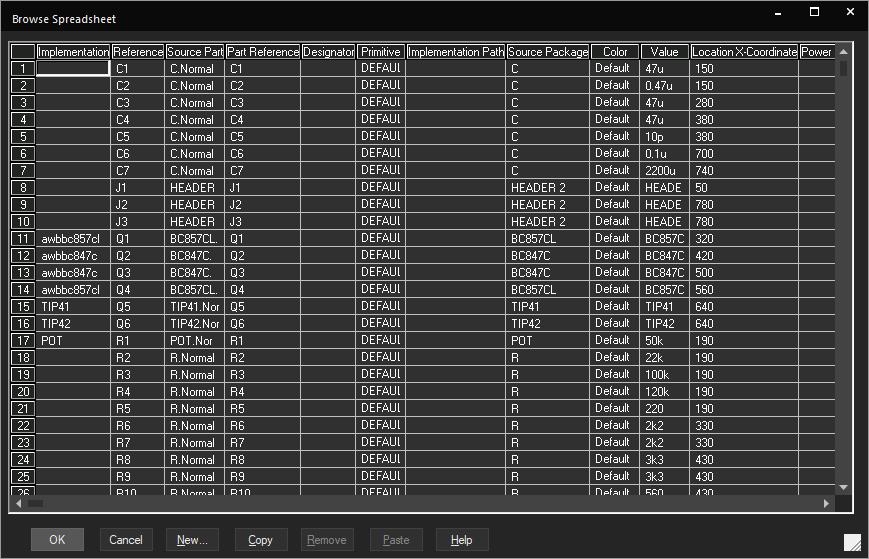
8. Locate the PCB Footprint column and enter the following values for PCB Footprint:
Capacitors: C1, C3, C4 : CAPC3225X270N, C2, C5, C6 : C1608, C7 : CAPC3225X270N
Resistors: RESC1608X55N
POT: 3361P1253GLF
Connectors: J1 – J3 : HDRV2W66P0X254_1X2_508X254X874P
Transistors: Q1, Q4 : BC857215, Q2, Q3 : BC847215, Q5, Q6 : TO254P470X1016X2019-3P
9. Left-click>OK to close the Browse Spreadsheet and right-click>Save and then Close on the Browse tab to save the property edits.
Using generic libraries from the installation:
1. Select the part J1 and right-click>Edit Properties to launch the Property Editor (double-click on the part J1 will also bring up the same Property Editor).
2. Enter a value for the PCB Footprint property for J1 in the appropriate cell. In this example the PCB Footprint is called jumper2, you only need to specify a PCB Footprint name, no extensions are required.
3. Save the changes and close the Property Editor with the “x” in the tab.
You can apply other properties to parts using this method like Manufacturer, Part Number, and Tolerance etc. Properties on parts are used to create PCB Editor Netlist files and manufacturing data like a Bill of Materials. A second method to add many properties in one step is to use the Browse method.
4. Select the headphone.dsn in the project pane then Edit>Browse>Parts

5. Accept the message about the property preferred mode. (For further information on Instances vs Occurrences properties please refer to the OrCAD Capture User Guide).
6. You will now see a list of all the parts in the Capture design. We only need to be concerned with the parts that will be used for the Physical layout. We can ignore the PSpice parts so, left-click C1 followed by a shift+left-click R16, the rows will highlight

7. Choose Edit>Properties (or CTRL+E) to launch the Browse Spreadsheet window. This is an editable table where you can edit existing property values or add new Property values like Manufacturer, Part Number that will be used for the Bill of Materials.

8. Locate the PCB Footprint column and enter the following values for PCB Footprint:
Capacitors: C1 – C6 : smc0805, C7 : smc1210
Resistors: smr0805
POT: VRES10
Connectors: J1 – J3 : jumper2
Transistors: Q1 – Q4 : to236ab, Q5 – Q6 : to252aa
9. Left-click>OK to close the Browse Spreadsheet and right-click>Save and then Close on the Browse tab to save the property edits.
Use File>Save from the menu to save the current schematic.
Now that the schematic has been completed, either move to the Simulating the headphone circuit with PSpice section. Or, if not simulating the circuit move to the either Physical Layout with OrCAD X Presto section. or move on to the Physical Layout with OrCAD X PCB Editor section.
Copyright © 2025, Parallel Systems Ltd.
All rights reserved.
